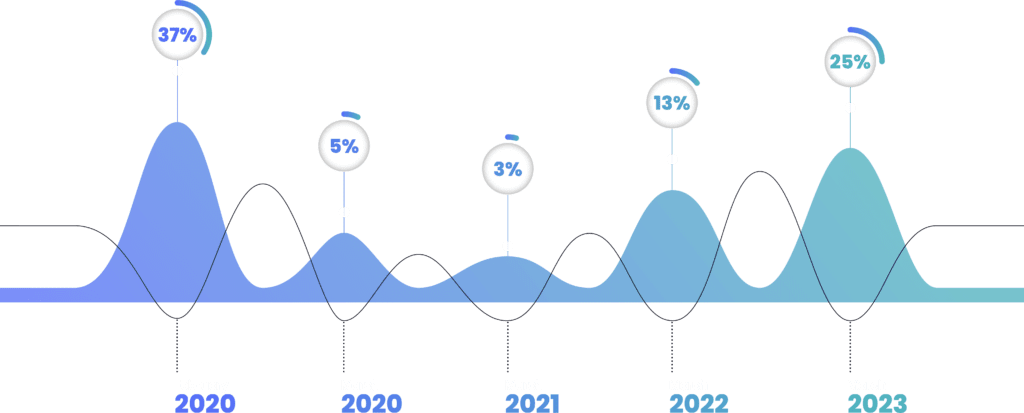Optimize Your Workplace With Multi-Data Point Analysis


THE QUESTION
With the increasing adoption of hybrid work, how can organizations effectively strike the right balance between delivering work environments that match how employees work best while also identifying opportunities to cut down on unnecessary real estate costs?
Learn how multi-data point analysis can help companies confidently optimize their workplaces for the ultimate employee and visitor experience, while also improving their bottom lines.
What is Multi-Data Point Analysis?

3 out of 4 business leaders say they lack reliable space utilization data to make informed real estate decisions.
Multi-data point analysis consolidates a variety of objective data and workplace intelligence into a single view for companies to easily identify areas within their workplaces and real estate portfolios.
By automating workplace data gathering and reporting with a multi-data point analysis solution, organizations gain helpful cross-product insights, including:
Employee attendance
Areas of underutilization and congestion
Departmental utilization
Allocation to the size, frequency, and duration of meetings
Environmental and energy factors, like lighting, heating, cooling, and air quality
WHY USE MULTI-DATA POINT ANALYSIS?
1. Deliver the types of workplaces hybrid workers are actually excited to commute in for, and be ready to do their best work
Organizations must realize they can no longer assume that the real estate they have is what people want to come back to. To meet new employee expectations and the normalization of job hopping, smart organizations know that refocusing their workplaces on ones that offer opportunities for collaboration, culture-building and ideation are better positioned to compete for talent. Integrating a multi-data point analysis solution helps leadership understand whether the workplace is fit for this purpose – or if it must pivot to change their size, location or space.

76% of business leaders acknowledge hybrid will lead other work models because it allows employees to achieve a better work-life balance.
1 out of 3 business leaders are prioritizing investing in the right workspace aligned with the culture and mission of their organization.

WHY USE MULTI-DATA POINT ANALYSIS?
1. Deliver the types of workplaces hybrid workers are actually excited to commute in for, and be ready to do their best work
Organizations must realize they can no longer assume that the real estate they have is what people want to come back to. To meet new employee expectations and the normalization of job hopping, smart organizations know that refocusing their workplaces on ones that offer opportunities for collaboration, culture-building and ideation are better positioned to compete for talent. Integrating a multi-data point analysis solution helps leadership understand whether the workplace is fit for this purpose – or if it must pivot to change their size, location or space.
76% of business leaders acknowledge hybrid will lead other work models because it allows employees to achieve a better work-life balance.

1 out of 3 business leaders are prioritizing investing in the right workspace aligned with the culture and mission of their organization.

43% of business leaders consider reducing real estate expenses as a top priority in the next 1-3 years.

2. Identify real estate cost-reduction opportunities
Because real estate is the second biggest expense behind employee salaries, multi-point data analysis solutions provide companies valuable insights into performance of their new work arrangements and real estate portfolio. By examining how, when and why their workplaces are being used, organizations can identify significant cost-reduction opportunities.
2. Identify real estate cost-reduction opportunities
Because real estate is the second biggest expense behind employee salaries, multi-point data analysis solutions provide companies valuable insights into performance of their new work arrangements and real estate portfolio. By examining how, when and why their workplaces are being used, organizations can identify significant cost-reduction opportunities.
43% of business leaders consider reducing real estate expenses as a top priority in the next 1-3 years.

3. Provide continuous analytics for a future-ready workplace
Based on FM:Systems global customer workplace sensor data, utilization rates averaged:

Today, utilization rate has become the most common metric for guiding CRE operations and performance—prioritized above both occupancy costs and employee engagement/satisfaction (according to CBRE & CorNet Global).
With hybrid work still in its infancy, workplace needs are constantly changing. The only way organizations can really be prepared to correctly evolve and optimize their workplaces is with a continuous stream of quality multiple workplace data sets.
Who benefits from multi-data point analysis?
Smaller, single-location organizations may not have the infrastructure, resources or complexity issues to make a robust workplace management solution worthwhile. Multi-data point analysis solutions are best for:


